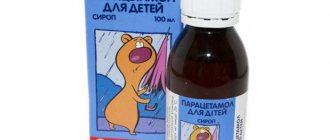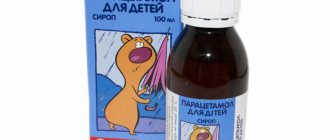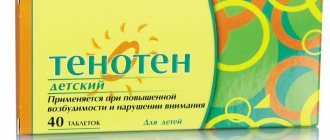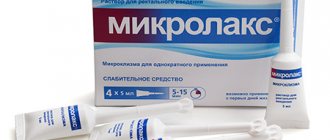Effect of the drug
Paracetamol has been considered a popular and sought after pain reliever and antipyretic for half a century. Efficiency is associated with uniform distribution across tissues.
The active ingredients block the action of prostaglandins, which are sources of pain. This eliminates moderate pain. The drug also copes well with fever. This serious symptom can indicate a variety of infectious and inflammatory diseases.
Before taking it, you should consult your doctor and read the instructions to prevent side effects. You should strictly follow the dosage, otherwise complications related to the functioning of the heart and kidneys may occur. The risk increases when taken concomitantly with alcoholic beverages.
Signs of poisoning do not appear immediately. Initially, your general well-being may only slightly deteriorate.
Paracetamol/acetaminophen is a drug from the anilides group, used for mild to moderate pain, fever and colds.
Synonyms Russian
N-(4-Hydroxyphenyl)acetamide, C8H9NO2, ifimol.
English synonyms
Paracetamol, Acetaminophen, Ifimol.
Research method
High performance liquid chromatography with tandem mass spectrometry.
Units
mcg/ml (micrograms per milliliter).
What biomaterial can be used for research?
Venous blood.
How to properly prepare for research?
- Children under 1 year of age should not eat for 30-40 minutes before the test.
- Do not eat for 2-3 hours before the test; you can drink clean still water.
- Do not smoke for 30 minutes before the test.
General information about the study
Paracetamol/acetaminophen is one of the most popular and most commonly used pain relievers and antipyretics worldwide. It serves as the drug of choice for patients for whom nonsteroidal anti-inflammatory drugs (NSAIDs) are contraindicated, in persons with bronchial asthma, peptic ulcer disease, hemophilia, among children, pregnant and lactating women. Paracetamol is well tolerated and, when dosed correctly, causes few gastrointestinal side effects, but the number of reported cases of liver damage caused by paracetamol is steadily increasing every year around the world.
Paracetamol is an analgesic-antipyretic, that is, a drug with analgesic, antipyretic and weak anti-inflammatory effects. The mechanism of action is associated with inhibition of prostaglandin synthesis, a predominant effect on the thermoregulation center in the hypothalamus by reducing its excitability. Paracetamol therapy is effective, well tolerated by most patients and safe, provided it is used in therapeutic doses. However, the use of paracetamol, even in therapeutic doses, in underweight individuals who abuse alcohol, or when taken together with other drugs, can cause serious liver damage. In addition, paracetamol is “hidden” in other drugs under different names. Long-term use of high doses of paracetamol carries a risk of adverse reactions such as hypertension, myocardial infarction or renal failure. In addition, side effects of paracetamol include agranulocytosis, thrombocytopenia, anemia, renal colic, aseptic pyuria, interstitial glomerulonephritis, and allergic reactions in the form of skin rashes. Symptoms of a drug overdose include pallor, nausea, vomiting and abdominal pain; after 12-48 hours, damage to the kidneys and liver may begin with the development of liver failure (encephalopathy, coma, death), cardiac arrhythmias and pancreatitis.
The use of paracetamol in children requires special care and selection of an adequate dosage (depending on age), which differs significantly from the standard adult dosage.
What is the research used for?
- Detection of toxic levels of the drug.
- Monitoring the concentration of paracetamol in the blood.
- Assessment of drug interactions.
When is the study scheduled?
- If an overdose of the drug is suspected.
- With the development of side effects of paracetamol.
What do the results mean?
Reference values: 10 - 20 µg/ml.
The results of the study are assessed by the attending physician taking into account the dose of paracetamol, its regimen, the patient’s age, concomitant pathology and individual tolerability of the drug.
After a single dose of 500 mg, the maximum concentration in the blood plasma is reached after 10-60 minutes and is about 6 mcg/ml, then gradually decreases and after 6 hours it is 11-12 mcg/ml.
What can influence the result?
- Metoclopramide increases the rate of absorption of acetaminophen.
- Cholestyramine reduces the rate of absorption of acetaminophen.
In what cases is it effective?
The drug has an effect in various febrile conditions associated with elevated temperature. Particularly effective for colds.
Paracetamol is able to cope with pain of varying intensity. It is often used for headaches and toothaches. Helps women with pain during menstruation.
The drug is allowed to be taken by pregnant women and babies from 3 months. For children there are baby candles and syrup. The product is often given to babies who are starting to cut their teeth.
Paracetamol for fever
Paracetamol can be used at a temperature if it has reached 38.5 degrees or higher. This is explained by the fact that elevated temperature has a negative effect on harmful microorganisms, and, therefore, allows you to recover faster.
It should be taken strictly according to the instructions, without exceeding the dosage. The tablet should be taken with a sufficient amount of drinking water, which will speed up the absorption of the active ingredient and minimize the negative impact on the liver.
Single dose 400-500 mg. If the temperature reaches 40 degrees, the dose can be doubled.
For children and adults, a single dose is determined based on weight. A child can take the drug 4 times per day. Duration of treatment – up to 3 days.
Paracetamol
The mechanism of action of paracetamol is currently poorly understood. The main proposed mechanism of action of the drug is inhibition of cyclooxygenase (COX). Recent results show that the substance is highly selective for COX-2. Due to its selectivity for COX-2, the substance does not significantly inhibit the production of thromboxanes. Although its analgesic and antifever activities are comparable to aspirin or other NSAIDs, its peripheral anti-inflammatory activity is usually limited by several factors, one of which is high levels of peroxides at inflammatory sites. In some cases, however, peripheral activity comparable to NSAIDs may be observed. A paper published in November 2011 by researchers from London, UK, and Lund, Sweden, in Nature Communications, describes a hypothesis regarding the analgesic mechanism of action of paracetamol. Metabolites of paracetamol, such as NAPQI, act on TRPA1 receptors in the spinal cord, inhibiting signal transduction from the outer layers of the dorsal horn, relieving pain. This assumption has been challenged in a new hypothetical paper about how paracetamol might work. The author acknowledges that NAPQI is an active metabolite, but states that this reactive compound must react not only with the thiol in TRPA1, but also with any other available nucleophiles. It is hypothesized that the analgesic effect may be provided by thiol groups in cysteine proteases, for example, cysteases important for the formation of procytokines, such as the cysteases that create IL-1β and IL-6. The COX family of enzymes is responsible for metabolizing arachidonic acid into prostaglandin H2, an unstable molecule that can in turn be converted into countless other pro-inflammatory compounds. Classic anti-inflammatory compounds such as NSAIDs block this conversion. The COX enzyme is only highly active when sufficiently oxidized. Paracetamol reduces the oxidized form of the COX enzyme, preventing the formation of pro-inflammatory compounds. This leads to a decrease in the amount of prostaglandin E2 in the central nervous system. Aspirin is known to inhibit the cyclooxygenase family of enzymes and since the action of paracetamol is partly similar to that of aspirin, much of the research has focused on whether paracetamol inhibits COX like aspirin. It is now known that paracetamol acts through at least two mechanisms. The exact mechanism by which COX is inhibited under different circumstances is still a matter of scientific debate. Due to differences in activity between paracetamol, aspirin and other NSAIDs, it is believed that other COX variants may exist. One theory states that paracetamol works by inhibiting the COX-3 isoform, a variant of the COX-1 family of COX enzymes. In dogs, this enzyme is similar to other COX enzymes, produces pro-inflammatory substances and is selectively inhibited by paracetamol. Studies, however, indicate that in humans and mice the COX-3 enzyme does not exhibit inflammatory activity and its inhibition by paracetamol in humans is not significant. Another theory is that paracetamol (like aspirin) blocks cyclooxygenase, but when there is inflammation (and high peroxide concentrations), the high oxidation of paracetamol prevents this effect. This would mean that paracetamol does not have any direct effect on the site of inflammation, but instead acts in the central nervous system (in a non-oxidative environment), reducing temperature, etc. Paracetamol also modulates the endogenous cannabinoid system. Paracetamol is metabolized into AM404, a compound with multiple mechanisms of action; most importantly, it inhibits the reuptake of the endogenous cannabinoid/vanilloid anandamide into neurons. Anandamide reuptake reduces synaptic levels of anandamide and increases activation of the major pain receptor (nociceptor) TRPV1 in the body. By inhibiting anandamide reuptake, levels at the synapse remain high, which can lead to desensitization of the TRPV1 receptor. Moreover, AM404 inhibits sodium channels like the anesthetics lidocaine and procaine. Both of these actions in themselves reduce pain and are possible mechanisms of action of paracetamol. However, it has been demonstrated that when cannabinoid receptors are blocked by synthetic antagonists, the analgesic effect of paracetamol is reduced, suggesting that its analgesic effect involves the endogenous cannabinoid system. Dorsal TRPA1 receptors also mediate the antinociceptive effects of paracetamol and Δ9-tetrahydrocannabinol in mice. The increase in social behavior in mice given paracetamol (and the decrease in social behavior in humans) is not associated with cannabinoid receptor type 1 activity. It may be due to agonism of the serotonin receptor.
How to take for headaches
The medicine is quite effective for headaches. But when taking it, it is worth considering some features. The tablets should not be taken on an empty stomach. Before taking the pill, you need to have at least something to eat. If there is no appetite, then you can drink a glass of water.
You need to take the tablet with plain water. It is not recommended to use coffee and tea, as the effect may be reduced to zero. If unbearable pain is felt, then you can take 1000 mg of the drug at a time. You can take the medicine again after at least 4 hours. You can take no more than 4 tablets per day. This regimen does not apply to pregnant women (the dosage should be 2 times less).
Paracetamol is prescribed for migraines, which are characterized by persistent, throbbing pain, usually in one part of the head.
If the headache is associated with stress or a nervous condition, then 1 tablet is enough.
Acetaminophen
From the skin: itching, rash on the skin and mucous membranes (usually erythematous, urticaria), angioedema, exudative erythema multiforme (including Stevens-Johnson syndrome), toxic epidermal necrolysis (Lyell's syndrome).
From the side of the central nervous system (usually develops when taking high doses): dizziness, psychomotor agitation and disorientation.
From the digestive system: nausea, epigastric pain, increased activity of liver enzymes, usually without the development of jaundice, hepatonecrosis (dose-dependent effect).
From the endocrine system: hypoglycemia, up to hypoglycemic coma.
From the hematopoietic organs: anemia, sulfhemoglobinemia and methemoglobinemia (cyanosis, shortness of breath, heart pain), hemolytic anemia (especially for patients with glucose-6-phosphate dehydrogenase deficiency). With long-term use in large doses - aplastic anemia, pancytopenia, agranulocytosis, neutropenia, leukopenia, thrombocytopenia.
From the urinary system: (when taking large doses) - nephrotoxicity (renal colic, interstitial nephritis, papillary necrosis). Overdose. Symptoms (acute overdose develops 6-14 hours after taking paracetamol, chronic - 2-4 days after exceeding the dose) of acute overdose: dysfunction of the gastrointestinal tract (diarrhea, loss of appetite, nausea and vomiting, abdominal discomfort and/or pain in stomach), increased sweating.
Symptoms of chronic overdose: a hepatotoxic effect develops, characterized by general symptoms (pain, weakness, adynamia, increased sweating) and specific ones characterizing liver damage. As a result, hepatonecrosis may develop. The hepatotoxic effect of paracetamol may be complicated by the development of hepatic encephalopathy (thought disturbances, central nervous system depression, stupor), convulsions, respiratory depression, coma, cerebral edema, hypocoagulation, development of disseminated intravascular coagulation syndrome, hypoglycemia, metabolic acidosis, arrhythmia, collapse. Rarely, liver dysfunction develops suddenly and can be complicated by renal failure (renal tubular necrosis).
Treatment: administration of SH-group donors and precursors for the synthesis of glutathione - methionine 8-9 hours after an overdose and N-acetylcysteine - after 12 hours. The need for additional therapeutic measures (further administration of methionine, intravenous administration of N-acetylcysteine) is determined in depending on the concentration of paracetamol in the blood, as well as on the time elapsed after its administration.
Paracetamol for colds
When a cold appears, you need to provide timely help. Otherwise, the condition may worsen. The first signs of the disease are excessive weakness and fatigue. During ARVI, a runny nose, cough, fever, muscle and joint pain appear.
Paracetamol will reduce the symptoms of the disease and improve the patient's condition.
Very often the drug is prescribed to adults and children over 12 years of age in tablet form. If the medicine is to be taken by children, then it is worth considering an important factor - the child must weigh more than 49 kg.
Babies up to one year old can be given the drug in the form of a suspension, after a year - in the form of syrup.
In many cases, adults take 1 tablet 4 times a day. Duration of treatment – no more than 3 days.
PARACETAMOL FOR CHILDREN
Directions for use and doses
5 ml of suspension contains 120 mg of paracetamol.
In one bottle the number of 5 ml doses is: 100 g - 16 doses, 150 g - 24 doses and 200 g - 32 doses. The drug is taken orally before meals in undiluted form, washed down with plenty of liquid. Shake the drug thoroughly before use. The frequency of administration is no more than 4 times a day with an interval of at least 4 hours.
The dose of paracetamol for children is calculated depending on age and body weight. A single dose of paracetamol is 10-15 mg/kg body weight, daily - no more than 60 mg/kg body weight.
For precise dosing of the drug, depending on the proposed configuration, use a measuring spoon or a measuring syringe included in the package.
If using a measuring syringe:
1. Shake the suspension thoroughly.
2. Open the bottle cap.
3. Insert the measuring syringe firmly into the hole in the adapter installed in the neck of the bottle.
4. Turn the bottle upside down and gently pull the plunger down, drawing the suspension into the measuring syringe to the desired level.
5. Return the bottle to its original position and remove the measuring syringe by gently turning it.
6. Give the drug to the child orally using a measuring syringe. To ensure smooth flow of the suspension into the oral cavity, slowly press the piston. After each use, rinse the measuring syringe in running water and dry it disassembled at room temperature out of the reach of children. The measuring syringe should be stored in the package along with the drug.
Depending on the age, Paracetamol for children is prescribed in the following single doses:
- from 1 to 3 months - for the symptomatic treatment of reactions to vaccination, a single dose of 2.5 ml of suspension is used. If necessary, the dose can be repeated, but not earlier than after 4 hours. If the child’s body temperature does not decrease after the repeated dose, you should consult a doctor. Further use of the drug in children of this age for the treatment of post-vaccination hyperthermia, as well as use in children aged 1-3 months for other indications is possible only under the supervision of a physician. If it is necessary to use the drug for a premature baby aged 1-3 months, the drug is prescribed only on the recommendation of a doctor.
- from 3 months to 1 year - 2.5-5 ml or 60-120 mg of paracetamol, depending on the child’s body weight (see table below);
- from 1 year to 6 years -5-10 ml or 120-240 mg depending on the child’s body weight (see table below);
- from 6 to 14 years - 10-20 ml or 240-480 mg, depending on the child’s body weight (see table below);
| Child's body weight | Single dose of the drug |
| 4-8 kg | 2.5 ml |
| 8-16 kg | 5 ml |
| 16-32 kg | 10 ml |
| more than 32 kg | 15-20 ml |
- adults - a single dose of 20 ml no more than 4 times a day.
The duration of treatment is no more than 3 days as an antipyretic and no more than 5 days as an analgesic. Continuation of treatment with the drug is possible only after consultation with a doctor!!!
Do not exceed the prescribed dose! An overdose of paracetamol can cause liver failure.
How to take for toothache
Often toothache catches a person at the most inopportune moment. Not in all cases it is possible to go to the dentist right away. To eliminate unbearable pain and improve the condition, you can take Paracetamol.
The drug is able to stop the production of prostaglandins, which are the source of pain. The tooth stops hurting, but the inflammatory process continues to spread. If the toothache does not go away, then you should not hesitate to go to the dentist.
You need to take the medicine after meals. Relief is observed after about 15-20 minutes. You can take the pill again no earlier than after 4 hours. You can take 4 tablets per day. Paracetamol can be taken for no more than 3 days.
Features of use by pregnant women
Pregnant women often complain of toothache. Most often, the cause is caries, which appears due to the fact that calcium in a woman’s body is directed to a greater extent towards the structure of the bone tissue of the unborn baby. This causes various problems, particularly with teeth.
Paracetamol is allowed to be taken by pregnant women, but precautions should be taken. The active substance can penetrate the placenta. The minimum dose of the medicine can be taken in the 2nd trimester, when the child’s organs are already formed.
Before taking it, you should consult your doctor. You can drink no more than 1 tablet per day. Repeated use may cause harm to the fetus.






